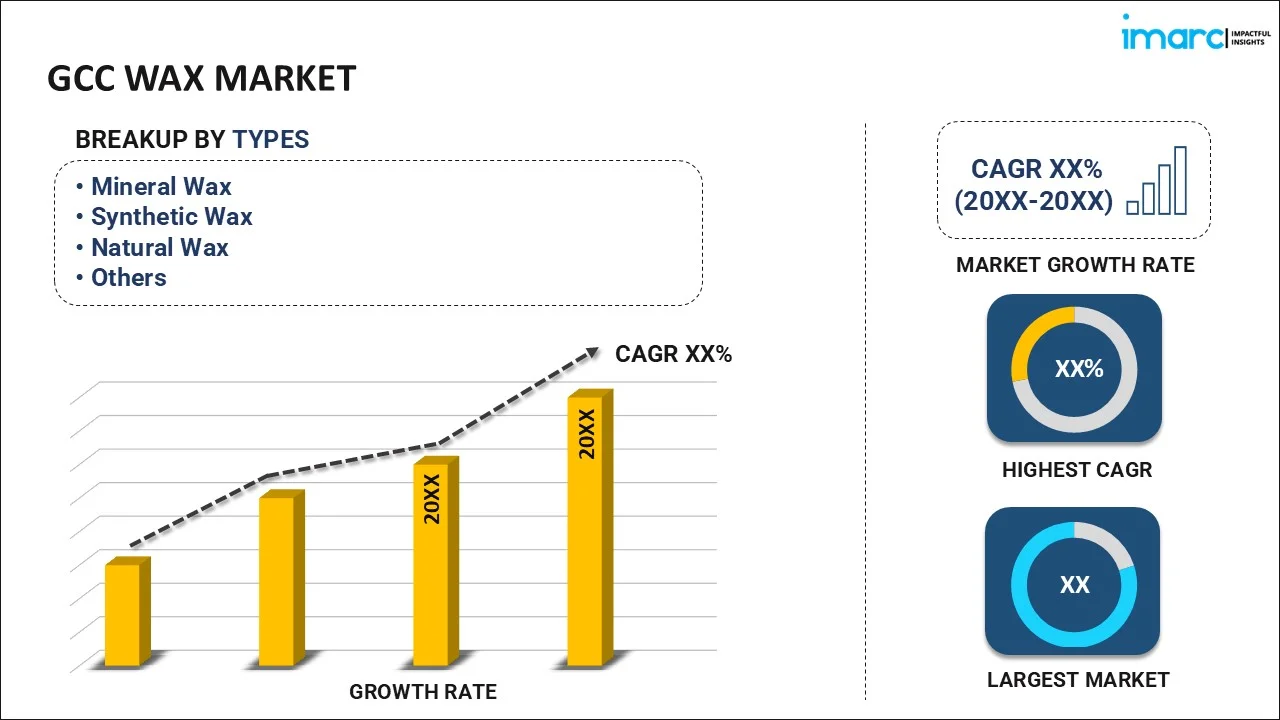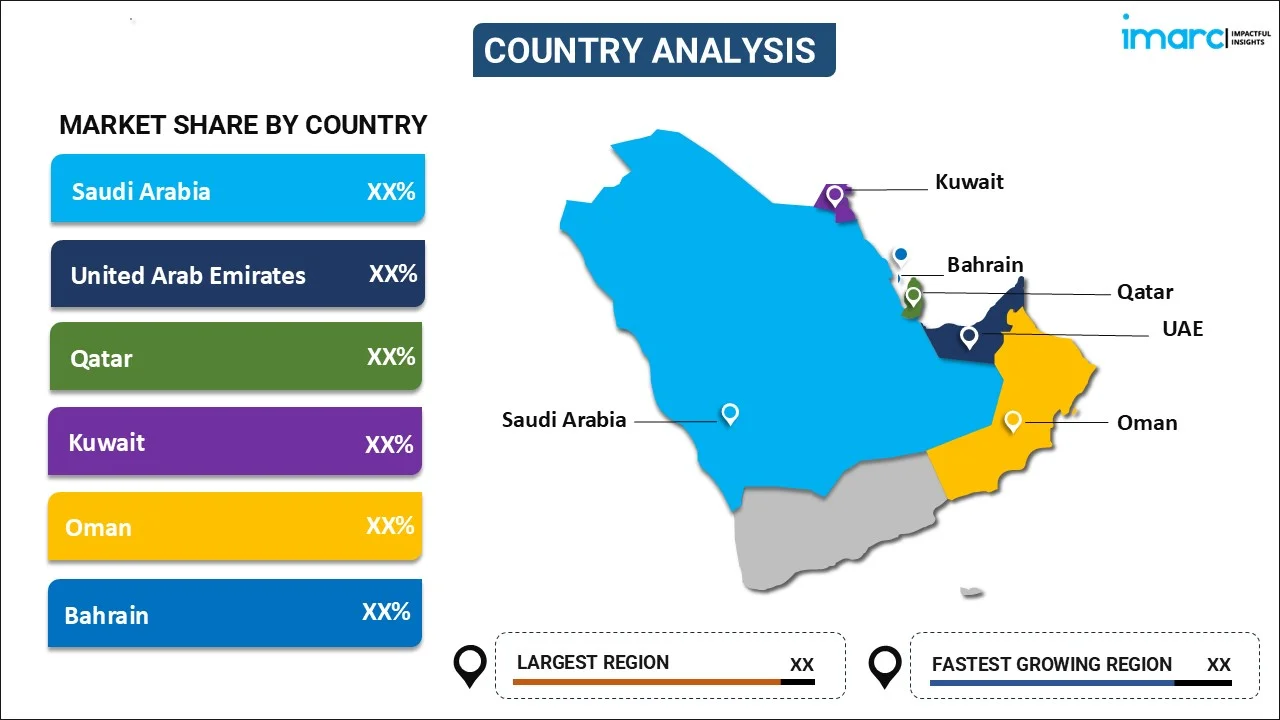
GCC Wax Market Report by Type (Mineral Wax, Synthetic Wax, Natural Wax, and Others), Form (Flakes, Granules, Powder, and Others), Application (Candles, Cosmetics, Packaging, Emulsions, Hot Melts, Floor Polishes, and Others), and Country 2025-2033
Market Overview:
The GCC wax market size reached USD 207.0 Million in 2024. Looking forward, IMARC Group expects the market to reach USD 300.0 Million by 2033, exhibiting a growth rate (CAGR) of 4.1% during 2025-2033. The increasing consumer demand for quality cosmetic and personal care products, the growing demand for high-quality, and performance-oriented waxes, and the advent of vegetable-based and synthetic waxes are some of the key factors driving the market.
|
Report Attribute
|
Key Statistics
|
|---|---|
|
Base Year
|
2024 |
|
Forecast Years
|
2025-2033
|
|
Historical Years
|
2019-2024
|
| Market Size in 2024 | USD 207.0 Million |
| Market Forecast in 2033 | USD 300.0 Million |
| Market Growth Rate (2025-2033) | 4.1% |
Wax is a broad term that describes a class of organic compounds characterized by malleability at room temperature and a water-repellent, protective nature. It comprises a range of substances that includes vegetable waxes, such as soy and carnauba, mineral waxes, including paraffin and microcrystalline, animal waxes, and synthetic waxes. Waxes are valued for their water-resistant properties, low reactivity, and non-toxic nature, making them suitable for a wide range of industrial applications. These materials share properties similar to resistance to moisture and air, non-reactivity, and low toxicity, making them suitable for various industrial applications. For instance, waxes are often used in the cosmetics industry for their texture-enhancing properties, in the food industry for packaging and coating purposes, and in the automotive and aerospace sectors for polishing and protecting surfaces. Furthermore, they play a crucial role in the candle industry, creating a means for clean, controllable combustion. In essence, wax is versatile, making it an indispensable part of many manufacturing processes and end products.
GCC Wax Market Trends:
The gulf cooperation council (GCC) wax market has been exhibiting robust growth, driven by the expanding industrial base in GCC countries, which includes burgeoning sectors such as cosmetics, food processing, and automotive. The diverse applications of wax across these industries contribute significantly to the wax demand in this region. The cosmetics sector, for instance, is experiencing rapid growth owing to increasing consumer demand for quality cosmetics and personal care products. The use of wax in product formulations for its emollient and texture-enhancing properties propels the need for wax in this industry. Similarly, the region's food processing industry's growth also drives wax demand, which serves crucial roles in food preservation and packaging. In the automotive sector, wax is widely used for surface polishing and protection, creating an ever-present demand parallel to the automotive industry's growth. Notably, the development of the region's luxury car market specifically stimulates demand for high-quality, performance-oriented waxes. Along with this, sustainability trends have influenced the wax market, leading to increased demand for natural and synthetic waxes that align with environmental and health safety norms. Moreover, the advent of vegetable-based and synthetic waxes with lower environmental impact has been particularly significant. In confluence with this, research and development efforts aimed at producing high-performance, eco-friendly waxes are shaping market trends, adding another layer of dynamism to the GCC wax market. Furthermore, the escalating demand for versatile, high-performance, and environmentally friendly waxes is creating a positive market outlook.
GCC Wax Market Segmentation:
IMARC Group provides an analysis of the key trends in each segment of the GCC wax market report, along with forecasts at the regional and country levels for 2025-2033. Our report has categorized the market based on type, form, and application.
Type Insights:

- Mineral Wax
- Synthetic Wax
- Natural Wax
- Others
The report has provided a detailed breakup and analysis of the market based on the type. This includes mineral wax, synthetic wax, natural wax, and others.
Form Insights:
- Flakes
- Granules
- Powder
- Others
A detailed breakup and analysis of the market based on the form has also been provided in the report. This includes flakes, granules, powder, and others.
Application Insights:
- Candles
- Cosmetics
- Packaging
- Emulsions
- Hot Melts
- Floor Polishes
- Others
The report has provided a detailed breakup and analysis of the market based on the application. This includes candles, cosmetics, packaging, emulsions, hot melts, floor polishes, and others.
Country Insights:

- Saudi Arabia
- UAE
- Qatar
- Bahrain
- Kuwait
- Oman
The report has also provided a comprehensive analysis of all the major regional markets, which include Saudi Arabia, UAE, Qatar, Bahrain, Kuwait, and Oman.
Competitive Landscape:
The report has also provided a comprehensive analysis of the competitive landscape in the market. Competitive analysis such as market structure, key player positioning, top winning strategies, competitive dashboard, and company evaluation quadrant has been covered in the report. Also, detailed profiles of all major companies have been provided.
GCC Wax Market Report Coverage:
| Report Features | Details |
|---|---|
| Base Year of the Analysis | 2024 |
| Historical Period | 2019-2024 |
| Forecast Period | 2025-2033 |
| Units | Million USD |
| Scope of the Report | Exploration of Historical and Forecast Trends, Industry Catalysts and Challenges, Segment-Wise Historical and Predictive Market Assessment:
|
| Types Covered | Mineral Wax, Synthetic Wax, Natural Wax, Others |
| Forms Covered | Flakes, Granules, Powder, Others |
| Applications Covered | Candles, Cosmetics, Packaging, Emulsions, Hot Melts, Floor Polishes, Others |
| Countries Covered | Saudi Arabia, UAE, Qatar, Bahrain, Kuwait, Oman |
| Customization Scope | 10% Free Customization |
| Post-Sale Analyst Support | 10-12 Weeks |
| Delivery Format | PDF and Excel through Email (We can also provide the editable version of the report in PPT/Word format on special request) |
Key Questions Answered in This Report:
- How has the GCC wax market performed so far and how will it perform in the coming years?
- What has been the impact of COVID-19 on the GCC wax market?
- What is the breakup of the GCC wax market on the basis of type?
- What is the breakup of the GCC wax market on the basis of form?
- What is the breakup of the GCC wax market on the basis of application?
- What are the various stages in the value chain of the GCC wax market?
- What are the key driving factors and challenges in the GCC wax market?
- What is the structure of the GCC wax market and who are the key players?
- What is the degree of competition in the GCC wax market?
Key Benefits for Stakeholders:
- IMARC’s report offers a comprehensive quantitative analysis of various market segments, historical and current market trends, market forecasts, and dynamics of the GCC wax market from 2019-2033.
- The research study provides the latest information on the market drivers, challenges, and opportunities in the GCC wax market.
- Porter's five forces analysis assist stakeholders in assessing the impact of new entrants, competitive rivalry, supplier power, buyer power, and the threat of substitution. It helps stakeholders to analyze the level of competition within the GCC wax industry and its attractiveness.
- Competitive landscape allows stakeholders to understand their competitive environment and provides an insight into the current positions of key players in the market.
Need more help?
- Speak to our experienced analysts for insights on the current market scenarios.
- Include additional segments and countries to customize the report as per your requirement.
- Gain an unparalleled competitive advantage in your domain by understanding how to utilize the report and positively impacting your operations and revenue.
- For further assistance, please connect with our analysts.
 Inquire Before Buying
Inquire Before Buying
 Speak to an Analyst
Speak to an Analyst
 Request Brochure
Request Brochure
 Request Customization
Request Customization




.webp)




.webp)












